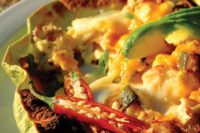The Migration of U.S. Ethnic Foods
Ethnic may seem like solely the domain of foreign foods, but Technomic’s Darreen Tristano explains that America has a number of regionally ethnic cuisines finding their way to menus and grocery aisles.

When one thinks “ethnic,” it usually refers to international foods, not homegrown cuisines. But, the U.S. is an ethnic melting pot in its own right. There are plenty of American foods and flavors that have taken root regionally in the States and are now flourishing nationwide and driving menu trends around heritage, tradition, fusion and the appeal of home-style comfort foods.
Regional American ethnic foods are growing in popularity. One only has to consider the explosion of food trucks as an example—a concept and menu-positioning trend that was arguably kicked off by the neighborhood Mexican food carts and street-food taco vendors that populated east L.A. long before mobile brands were rolling around California.
It was the general interest in and cravings for rustic, simple street foods that spurred trucks like Kogi Korean BBQ to develop mobile concepts. Kogi took two ethnic cuisines that were widely accepted in the West—Mexican and Asian—and combined them in an interesting signature fusion offering: Korean barbecue tacos. Since then, this regional favorite has popped up everywhere across the industry landscape, from food-truck copycats to mainstream chain menus nationwide, such as California Pizza Kitchen, Grand Lux Café and Granite City Food & Brewery.
Trendy, California-style street foods were preceded by the acceptance of Cajun and Creole foods representative of the Deep South. Louisiana food staples inspired by Native American, West African, French, Spanish and Italian culinary traditions were developed over time, as Cajun and Creole were perhaps the first ethnic-fusion cuisines apparent in the U.S.
Once beloved only by Louisiana natives and those living in or from the South, Creole foods, such as gumbo, jambalaya and étouffée appear in numerous interpretations on chain menus. The same can be said for traditional Cajun cooking methods and seasonings, such as blackened proteins and Cajun spice-rubbed barbecue.
Up next for American ethnic foods are:
- Grits—another Southern staple, grits are widely available as a breakfast side at regional restaurant chains, but the dish’s adaptability to flavors (much like polenta) makes it a candidate for inclusion in other, more gourmet preparations. Look for grits to appear in upscale offerings that highlight authenticity, such as Low Country shrimp and grits, a favorite of the Southeastern U.S.
- Pozole—with Southwestern- and Tex-Mex-style foods already in the mainstream, the acceptance of less-familiar Southwestern foods will likely continue. Pozole, a satisfying Southwestern comfort-food soup made with white hominy, may be the next Tex-Mex favorite to be introduced to menus that fall outside the Mexican category.
- "Micro” ethnic foods—as consumers search for authenticity in ethnic cuisine, expect emerging concepts to begin drilling down from wider regional influences to explore the flavors, techniques and preferences of specific states, cities and even streets or neighborhoods.
Looking for a reprint of this article?
From high-res PDFs to custom plaques, order your copy today!







